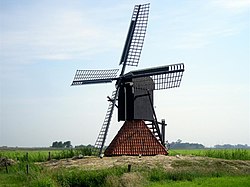For faster navigation, this Iframe is preloading the Wikiwand page for
De Jansmolen, Goëngahuizen.
De Jansmolen or De Modden is a Hollow Post mill in Goëngahuizen, Friesland, Netherlands which has been restored as a landscape feature. The mill is listed as a Rijksmonument, number 34000.[1]
The date that De Jansmolen was built is unknown. The mill was marked on a map of Smallingerland dated 1848. The mill was at work until 1952. During the summer it drained an area of 200 pondemaat (73 ha; 180 acres) and during the winter it drained an area of 60 pondemaat (22 ha; 54 acres).[2] The mill was restored in 1954 and 1967. On 9 November 1978, the mill was sold to Stichting De Fryske Mole (English: Frisian Mills Foundation). The mill was restored again in 1990.[2]
De Jansmolen is what the Dutch describe as an spinnenkop. It is a hollow post mill on a single-storey square roundhouse. The mill is winded by tailpole and winch. The roundhouse is clad in pantiles and mill body is covered in vertical boards, while the roof of the mill is boarded vertically and covered in felt. The sails are Common sails. They have a span of 14.00 metres (45 ft 11 in). The sails are carried on a cast-iron windshaft.[2] Apart from the brake wheel, the mill is devoid of machinery.[3]
De Jansmolen is open by appointment.[4]
{{bottomLinkPreText}}
{{bottomLinkText}}
This page is based on a Wikipedia article written by
contributors (read/edit).
Text is available under the
CC BY-SA 4.0 license; additional terms may apply.
Images, videos and audio are available under their respective licenses.
De Jansmolen, Goëngahuizen
{{current.index+1}} of {{items.length}}
Thanks for reporting this video!
This browser is not supported by Wikiwand :(
Wikiwand requires a browser with modern capabilities in order to provide you with the best reading experience.
Please download and use one of the following browsers:
An extension you use may be preventing Wikiwand articles from loading properly.
If you're using HTTPS Everywhere or you're unable to access any article on Wikiwand, please consider switching to HTTPS (https://www.wikiwand.com).
An extension you use may be preventing Wikiwand articles from loading properly.
If you are using an Ad-Blocker, it might have mistakenly blocked our content.
You will need to temporarily disable your Ad-blocker to view this page.
✕
This article was just edited, click to reload
Please click Add in the dialog above
Please click Allow in the top-left corner,
then click Install Now in the dialog
Please click Open in the download dialog,
then click Install
Please click the "Downloads" icon in the Safari toolbar, open the first download in the list,
then click Install
{{::$root.activation.text}}
Follow Us
Don't forget to rate us
Oh no, there's been an error
Please help us solve this error by emailing us at
support@wikiwand.com
Let us know what you've done that caused this error, what browser you're using, and whether you have any special extensions/add-ons installed.
Thank you!


